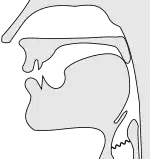Voiced uvular plosive
The voiced uvular plosive or stop is a type of consonantal sound, used in some spoken languages. The symbol in the International Phonetic Alphabet that represents this sound is ⟨ɢ⟩, a small capital version of the Latin letter g, and the equivalent X-SAMPA symbol is G\.
| Voiced uvular plosive | |||
|---|---|---|---|
| ɢ | |||
| IPA Number | 112 | ||
| Audio sample | |||
|
source · help | |||
| Encoding | |||
| Entity (decimal) | ɢ | ||
| Unicode (hex) | U+0262 | ||
| X-SAMPA | G\ | ||
| Braille | |||
| |||
[ɢ] is a rare sound, even compared to other uvulars.[1] proposes a phonological explanation: uvular consonants normally involve a neutral or a retracted tongue root, whereas voiced stops often involve an advanced tongue root: two articulations that cannot physically co-occur. This leads many languages of the world to have a voiced uvular fricative [ʁ] instead as the voiced counterpart of the voiceless uvular plosive. Examples are Inuit; several Turkic languages such as Uyghur and Yakut; several Northwest Caucasian languages such as Abkhaz; several Mongolic languages such as Mongolian language and Kalmyk language as well as several Northeast Caucasian languages such as Ingush.
There is also the voiced pre-uvular plosive[2] in some languages, which is articulated slightly more front compared with the place of articulation of the prototypical uvular plosive, though not as front as the prototypical velar plosive. The International Phonetic Alphabet does not have a separate symbol for that sound, though it can be transcribed as ⟨ɢ̟⟩ (advanced ⟨ɢ⟩), ⟨ɡ̠⟩ or ⟨ɡ˗⟩ (both symbols denote a retracted ⟨ɡ⟩). The equivalent X-SAMPA symbols are G\_+ and g_-, respectively.
Features

Features of the voiced uvular stop:
- Its manner of articulation is occlusive, which means it is produced by obstructing airflow in the vocal tract. Since the consonant is also oral, with no nasal outlet, the airflow is blocked entirely, and the consonant is a plosive.
- Its place of articulation is uvular, which means it is articulated with the back of the tongue (the dorsum) at the uvula.
- Its phonation is voiced, which means the vocal cords vibrate during the articulation.
- It is an oral consonant, which means air is allowed to escape through the mouth only.
- It is a central consonant, which means it is produced by directing the airstream along the center of the tongue, rather than to the sides.
- The airstream mechanism is pulmonic, which means it is articulated by pushing air solely with the intercostal muscles and diaphragm, as in most sounds.
Occurrence
| Language | Word | IPA | Meaning | Notes | |
|---|---|---|---|---|---|
| Arabic | Sudanese | بقرة | [bɑɢɑrɑ] | 'cow' | Corresponds to /q/ in Standard Arabic. See Arabic phonology |
| Yemeni[3] | قات | ⓘ | 'Khat' | Some dialects.[3] Corresponds to /q/ in Standard Arabic. See Arabic phonology | |
| English | Australian[4] | gaudy | [ˈɡ̠oːɾi] | 'gaudy' | Pre-uvular; allophone of /ɡ/ before /ʊ oː ɔ oɪ ʊə/.[4] See Australian English phonology |
| Ket[5] | báŋquk | [baŋ˩˧ɢuk˧˩] | 'cave in the ground' |
Allophone of /q/ after /ŋ/.[5] | |
| Kwak'wala | ǥilakas'la | [ɢilakasʔla] | 'thank you' | ||
| Lishan Didan | Urmi Dialect | בקא/baqqa | [baɢːɑ] | 'frog' | Allophone of /q/ when between a vowel/sonorant and a vowel. |
| Malto | तेंग़े | [t̪eɴɢe] | 'to tell' | Allophone of /ʁ/ after /ŋ/, /ʁ, ŋʁ/ is /h/ in Southern and Western dialects. | |
| Mongolian | Монгол ᠮᠣᠩᠭᠣᠯ | [mɔɴɢɔ̆ɮ] | 'Mongolian' | Allophone of /g/ before back vowels, phonemic word-finally. | |
| Nivkh | ньыӈ ӷан | [ɲɤŋ ɢæn] | 'our dog' | Allophone of /q/. | |
| Persian | Iranian | قهوه | [ɢæhˈve] | 'coffee' | See Persian phonology. |
| Somali | Muqdisho | [muɢdiʃɔ] | 'Mogadishu' | Allophone of /q/. See Somali phonology | |
| Tabasaran | дугу | [d̪uɢu] | 'he' (ergative) | ||
| Tlingit | ghooch | [ɢuːt͡ʃʰ] | 'hill' | In American orthography, the 'g' is underlined; in Canadian, it is followed by an 'h'. See Tlingit phonology | |
| Tsakhur | къгяйэ | [ɢajɛ] | 'stone' | ||
| Turkmen | gar | [ɢɑɾ] | 'snow' | An allophone of /ɡ/ next to back vowels | |
| !Xóõ | [nǀɢɑɑ̃] | 'to be spread out' | |||
| Xumi | Lower[6] | [ɢʶo˩˥] | 'to stew' | Slightly affricated; occurs only in a few words.[7] Corresponds to the cluster /Nɡ/ in Upper Xumi.[8] | |
| Yanyuwa[9] | kuykurlu | [ɡ̠uɡ̟uɭu] | 'sacred' | Pre-uvular.[9] Contrasts plain and prenasalized versions | |
See also
Notes
- Vaux, Bert (1999). "A Note on Pharyngeal Features". Harvard Working Papers in Linguistics.
- Instead of "pre-uvular", it can be called "advanced uvular", "fronted uvular", "post-velar", "retracted velar" or "backed velar". For simplicity, this article uses only the term "pre-uvular".
- Watson (2002), p. 13.
- Mannell, Cox & Harrington (2009).
- Georg (2007), pp. 49, 67 and 77.
- Chirkova & Chen (2013), p. 365.
- Chirkova & Chen (2013), pp. 365–366.
- Chirkova, Chen & Kocjančič Antolík (2013), pp. 383, 387.
- Ladefoged & Maddieson (1996), pp. 34–35.
References
- Chirkova, Katia; Chen, Yiya (2013), "Xumi, Part 1: Lower Xumi, the Variety of the Lower and Middle Reaches of the Shuiluo River" (PDF), Journal of the International Phonetic Association, 43 (3): 363–379, doi:10.1017/S0025100313000157
- Chirkova, Katia; Chen, Yiya; Kocjančič Antolík, Tanja (2013), "Xumi, Part 2: Upper Xumi, the Variety of the Upper Reaches of the Shuiluo River" (PDF), Journal of the International Phonetic Association, 43 (3): 381–396, doi:10.1017/S0025100313000169
- Georg, Stefan (2007), A Descriptive Grammar of Ket (Yenisei-Ostyak), Global Oriental
- Ladefoged, Peter; Maddieson, Ian (1996), The Sounds of the World's Languages, Oxford: Blackwell, ISBN 978-0-631-19815-4
- Mannell, R.; Cox, F.; Harrington, J. (2009), An Introduction to Phonetics and Phonology, Macquarie University
- Watson, Janet (2002), The Phonology and Morphology of Arabic, New York: Oxford University Press
